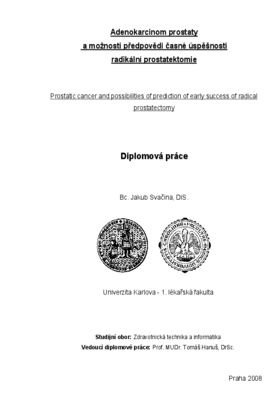Adenokarcinom prostaty a možnosti předpovědi časné úspěšnosti radikální prostatektomie
Prostatic cancer and possibilities of prediction of early success of radical prostatectomy
diplomová práce (OBHÁJENO)

Zobrazit/
Trvalý odkaz
http://hdl.handle.net/20.500.11956/17998Identifikátory
SIS: 62277
Katalog UK: 990010041870106986
Kolekce
- Kvalifikační práce [4870]
Autor
Vedoucí práce
Oponent práce
Zachoval, Roman
Fakulta / součást
1. lékařská fakulta
Obor
Zdravotnická technika a informatika
Katedra / ústav / klinika
Ústav biofyziky a informatiky 1. LF UK v Praze
Datum obhajoby
19. 9. 2008
Nakladatel
Univerzita Karlova. 1. lékařská fakultaJazyk
Čeština
Známka
Velmi dobře
Pro léčbu adenokarcinomu prostaty je důležitá klasifikace pokročilosti onemocnění. V práci jsem v úvodu popsal podrobně toto onemocnění a jeho léčbu. Na získaném souboru 52 pacientů urologické kliniky indikovaných k radikální prostatektomii jsem porovnal klasifikaci předoperační a operační Gleasonovým skóre. Již jednoduchými statistickými metodami lze analyzovat vztah předoperačního vyšetření, operačního histologického nálezu a časného pooperačního vývoje PSA. Předoperační vyšetření PSA mírně podhodnocuje kategorii T ve srovnání s definitivní histologií. Pokles PSA je signifikantně vyšší u pacientů s vysokým iniciálním PSA a u pacientů s klasifikací T2N0M0. Hodnota iPSA ( iniciální, předoperační) PSA měsíc po operaci se neliší u pacientů s T1C a T2 a nekoreluje s žádnou z předoperačních charakteristik. Pravděpodobně tedy závisí jen na operaci samotné. Pacienta s úspěšným efektem operace na pokles PSA nelze tedy predikovat věkem ani Gleasonovým skóre. Uvedené výsledky se vztahují pouze na pacienty indikované k radikální prostatektomii.
Classification of adenocarcinoma prostatae is very important for the treatment. I have described the disease, its treatment and classification in the introduction. I have analysed a sample of 52 patients from the Urological Clinic of General Faculty Hospital. Simple statistics was used for comparing and analysing of relation of preoperative classification and postoperative development of PSA. I have compared preoperative and operative Gleason's score. Preoperative Gleason score underscores the operative score. PSA decrease is significantly higher in patients with high initial PSA and in patients with classification T2N0M0. PSA one month after surgery does not differ in patients with classification T1C and T2 and it does not correlate with the preoperative characteristics of patients. The decrease of PSA is perhaps dependent only on the surgical treatment. Effect of operation cannot be predicted by Gleason score and by age. These results are valid only for patients undergoing radical prostractomy
